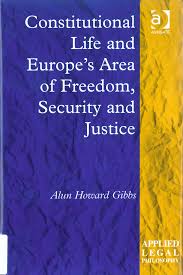 by Alun Howard Gibbs. Farham, England and Burlington, Vermont: Ashgate Publishing, 2011. 150pp. Hardback $115, ISBN 9781049402695.
by Alun Howard Gibbs. Farham, England and Burlington, Vermont: Ashgate Publishing, 2011. 150pp. Hardback $115, ISBN 9781049402695.Reviewed by Dagmar Soennecken, School of Public Policy and Administration, York University, Toronto, Canada. e-mail: dsoennec [at] yorku.ca
pp.566-567
In CONSTITUTIONAL LIFE, Alun Howard Gibbs offers a refreshing and thoughtful take on the European Union’s (EU) Area of Freedom, Security and Justice (AFSJ), which is still a fairly recent and perhaps the most rapidly expanding area of EU competence. Fundamental to the policy arenas encompassed by the AFSJ – ranging from asylum and immigration to crime, judicial cooperation and policing – is the question of how a community such as the EU balances the three aspects of the AFSJ referred to in the book’s title – freedom, security and justice – and more precisely, what this balance tells us about the EU as a polity, the process of integration and the nature of the EU’s “constitutional commitments.”
Gibbs pursues this question by anchoring his analysis in constitutional theory, which occupies the first chapter of the book. In it, he weaves together a historical account of the AFSJ’s development as a policy area with debates about the EU’s contested legitimacy as a polity. He shows that the AFSJ, which he primarily characterizes as being emblematic of the EU’s internal security concerns, has come to be too “closely bound up with concerns over constitutional legitimacy of the EU” (p.21). Constitutional legitimacy, he argues in chapter two, is weak and has been reduced to debates about the proper constraints on political power, thereby neglecting other aspects of legitimacy, such as its link to authority and social identity (p.24). Gibbs defines authority as being 1) sustained by a deliberative process of ‘rightness’ (p.32), or an engagement with our past constitutional commitments over time that is firm yet fluid because it represents a set of possibilities and promises, and 2) inclusive, in that it invites participation in the construction of the meaning of constitutional legitimacy by all members of the polity.
Unsurprisingly, it becomes quickly clear in chapter three, that security is the most problematic aspect of the AFSJ’s competences, having risen to the status of a “super public good” (p.65). As well, Gibbs reminds us throughout the book that instrumental notions of security, in particular practices (or ‘techniques’) of ‘governmentality,’ have virtually displaced other constitutive elements of security, among them its reflective, social and inter-subjective aspects. Gibbs cautions that we further need to be mindful of the spillover effect of instrumentalist notions of security (p.80). It is easy for other public goods to be similarly affected.
The two subsequent chapters offer a more detailed examination of two of the AFSJ’s common areas – freedom of [*667] movement and criminal justice – in light of Gibb’s arguments about the dominance of security and his overall theoretical framework. Both chapters contain a substantive engagement with historical developments of these EU competences, include examples of debates about concrete policy measures (ranging from Schengen and EURODAC to the European Arrest Warrant), discuss relevant court decisions, and survey critical scholarship on the two areas.
With respect to criminal justice Gibbs contends that it is at the heart of the AFSJ and thus the EU’s constitutional life. It “has become so intertwined with the claim to sovereign authority (of the state)” (p.105) that it is essential to probe the tensions over the relationship between existing common criminal justice measures and the political order. The central issue for Gibbs is the question of mutual recognition and political trust, “which is necessary to orientate the political community towards the just criminal order” (p.121). While Gibbs’ analysis shows that European criminal law shows more signs of being developed in conjunction with these constitutional values, he concludes that freedom of movement has been so overshadowed by instrumentalist acts to close off the area (which for Gibbs is not equivalent to the physical space) in the name of security, that it distorts and displaces other constitutional norms, among them freedom and justice.
In his conclusion, Gibbs emphasizes once again the need to resist the instrumentalist thinking and language prevalent in most writings on the AFSJ and indeed, on EU constitutionalism. He advocates a wider participation in constitutional thinking and learning so that it becomes a legitimate practice (p.132), which ultimately involves learning to live with risk (p.137).
Gibbs’ book is relatively slim. Yet he manages to facilitate a dialogue across a wide range of theories, issues and complex policy debates. It is this breadth and the ease with which Gibbs navigates the different aspects of this constitutional conversation that constitute the most important contribution of this book. The book also serves as an important reminder that we should hold the rapid developments in the Area of Freedom, Security and Justice to a high standard as it is intrinsically linked to the EU’s fundamental values. As a migration scholar, I was somewhat surprised that Gibbs did not include a critical discussion of the initial linkage of migration with security, which later came to be institutionalized in the AFSJ. I was also left wondering what the implications would be of Gibbs’ call to participate in the process of learning and reconstituting the EU’s constitutional life, for those migrants that have been repeatedly cast as objects in EU law.
Overall, although scholars studying critical security studies, EU migration, or criminal justice may find this book appealing, it might be of greater interest to law and courts readers well versed in political and legal theory, in particular hermeneutics.
Copyright 2013 by the author, Dagmar Soennecken.